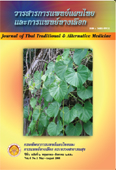Efficacy of Orthosiphon aristatus and Norfloxacin in the Treatment of Patients with Multiple Chronic Health Complaints under Restriction of Purine-rich Food
Main Article Content
Abstract
Nephrolithiasis in northeastern Thailand frequently presents with multiple chronic health complaints (MCHC), namely, myofascial pain, back pain, dyspepsia, arthralgia, headache, fatigue, frank paresthesia, dysuria, and any of these aggravated by purine-rich food (PRF). We previously reported that long-term
consumption of Orthosiphon aristatus (Blume) Miq. (OA) herbal tea could relieve certain health complaints and cause some reduction of stone size in nephrolithic patients with MCHC and positive white blood cells (WBC) in the urine. The objective of this study was to compare the efficacy of OA or OA plus norfloxacin (NFL) in the treatment of MCHC subjects with negative or positive urine white blood cells. A double-concealed, randomized, controlled trial was conducted in 15 rural villages in Khon Kaen Province from February through July 2005 on 209 MCHC subjects enrolled and 193 evaluated (75 without WBC and 118 with WBC), and randomly assigned into 4 groups, as follows: G1 (39), G2 (36), G3 (60) and G4 (58). Placebo with OA (extract of 1.7 g dried leaves), norfloxacin 400 mg (NFL) and OA+NFL, all in identical capsules, were given to G1, G2, G3 and G4, respectively. The medications were packed, then their codes were concealed. Every group was instructed to avoid purine-rich food (PRF) during the two-week treatment period. Therapeutic success, defined as the reduction of the VAS score 50 percent in 50 percent of the subjects, for each active MCHC symptom. The results showed subjects in every group reduced their PRF intake during treatments by 90 percent and each active symptom was significantly decreased (p<0.001, Friedman Test); thus, therapeutic success was reached within two weeks. A statistically significant difference between the groups was not found. Only the reactive MCHC symptoms of the subjects in G1 (placebo group) did not decrease, while those in the other groups (G2, G3, G4) significantly decreased (p<0.05, Pearson chi-square). The study concluded that
PRF-restriction significantly reduced MCHC symptoms among all treatment groups within two weeks and the incidence of the reactive MCHC symptoms of G2, G3 and G4 were significantly reduced in the second week while they did not decrease in the placebo group (G1).
Article Details
References
2.Yanagawa M, Kawamura J, Onishi T, Saga N, Kameda K, Sriboonlue P, Prasongwatana V, BoTWompadughlcitti S. Incidence of urolithiasis in northeast Thailand. lnt J Ural 1997;4:537-40.
3.Premgamone A, Sriboonlue P, Ditsatapornjaroen W, Maslcasem S, Sinsupan N and Apinives C. A long-term study on the efficacy of a herbal plant, Orthosiphon grandiflorus, and sodium potassium citrate in treatment of renal calculi. Southeast Asian J Trap Mad Public Health 2001;32:654-ilO.
4.Premgamone A, Sriboonlua P, Ditsatapornjaroan W, Maslcasem S. Distribution of the sizes of kidney stone in a community survey. Asian J Radial 2008 (in press).
5.Choi HK. Atkinson K, Karlson EW. Willett W, Curhan G. Purine-rich foods, dairy and protein intake, and the risk of gout in men. N Engl J Mad. 2004;350: 1093-103.
6.Lammers RL. GibsonS, Kovacs D. Sears W, Strachan G. Comparison of test characteristics of urine dipstick and urinalysis at various test cutoff points. Ann Emerg Med 2001 ;38:505-12.
7.Bonnarddeaux A, Sommerville P, Kaye M. A study on the reliability of dipstick urinalysis. Clin Nephrol 1994;41:167-72.
B. Christenson RH, Tucker JA, Allen E. Results of dipstick tests, visual inspection, microscopic examination of urine sediment, and microbiological cultures of urine compared for simplifying urinalysis. Clin Cham 1985;31:448-50.
9. Chen CP, Lin CC, Namba T. Screening of Taiwanese drugs for antibacterial activity against Streptococcus mutans. J Ethnopharmacol 1989;27:285-95.
10. Premgamone A, Ditsatapornjaroen W, Maslcasem S, Kessomboon P. Purine-rich food consumption and its association with subjective health complaints (SHC) in rural villages in Khan Kaen. Thailand. Program and abstract book. WONCA Asia Pacific Regional Conference 2006: Happy and Healthy Family, Bangkok, Thailand; November 5-9, 2006, p. 118.


